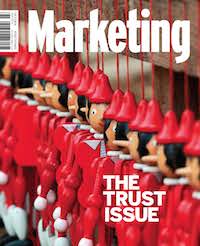Fine-tuning your LinkedIn content – insights from the inside
Share
More B2B marketers are including LinkedIn as an instrumental tool in reaching their desired audience. Prue Cox gives Marketing some advice for organisations hoping to make the most of the platform.
This article originally appeared in The Trust Issue, our June/July 2018 issue of Marketing magazine.
Marketing speaks with LinkedIn director of marketing solutions Prue Cox about lead generation, targeted content and marketing automation on LinkedIn.
Marketing: What are your recommendations for brands running content and lead generation activity on LinkedIn?

Prue Cox: It’s about understanding the split between brand activity and lead generation activity. Clients – B2B clients especially – probably skew a little bit more toward the lead generation side and forget about nurturing the audience with content. It’s so important to nurture your audience constantly with content in the feed. 5% of our members’ time on Linkedin is spent in the feed, consuming content. It’s a really ripe opportunity for marketers to actually engage with them.
What we’ve seen from our insights is, on average, it takes about seven to 10 pieces of content exposure before they’ll actually convert, actually respond to calls to action (CTA). It’s about understanding that split of upper funnel activity through sponsored content, as well as some of that stronger CTA content with lead generation activity.
So it’s important to focus on building an audience rather than getting out there straightaway with a call to action?
You’ve got to build that brand. Consumers won’t necessarily automatically just respond to a strong CTA. They do need to be nurtured through, they need to have exposure to the brand, and consistency of exposure to the brand and content before they’re ready to really take and engage with that CTA. We often have clients with a split of sponsored content that is really more around that upper funnel thought leadership, which then brings readers down through some lead generation forms to capture more qualified leads.
When you’re talking about conversions, are you referring to clicking through to a brand’s website?
 Not necessarily. We also have lead generation forms. Our lead gen forms are pre-populated, so if you click on a strong CTA – it may be to download a white paper or to find out more – it’ll actually bring up a lead generation form. That’s already pre-populated with member information. That’s not even taking members away. They can actually do that within the feed. Or, it may be that a client wants to actually do that lead generation or conversion onto their own site as well. It depends on the KPIs of the campaign.
Not necessarily. We also have lead generation forms. Our lead gen forms are pre-populated, so if you click on a strong CTA – it may be to download a white paper or to find out more – it’ll actually bring up a lead generation form. That’s already pre-populated with member information. That’s not even taking members away. They can actually do that within the feed. Or, it may be that a client wants to actually do that lead generation or conversion onto their own site as well. It depends on the KPIs of the campaign.
The more steps that you make people go through, then you do actually lose people along the way. With our product, it can happen at one or two clicks, and still keep them within the LinkedIn.
Are there any types of content that are performing better than others? Long form versus short form, for example?
It’s really going to depend on your audience, where they are in the funnel and how you’ve nurtured them. If you’re doing retargeting or matched audiences, where you’re targeting audiences that have already engaged with your brand, then they will actually be more engaged with some of the longer form pieces. If you’re starting a new relationship with different audiences or audience segments, then they’re not as likely to engage with some of those longer form pieces.
What we’re finding though, is video – a product we’ve recently just been in beta with and will be launching – as a content form, is 20 times more likely to be shared than any of our other forms of content, which is a really interesting insight.
We recommend with all of our clients and campaigns: test and optimise. It’s not about just creating new pieces of content, but repurposing content into different forms, and then starting to AB test. Compare multiple messages or versions of your ad creative and start to understand what’s going to resonate with different audiences. They say probably only about 20% of your content is really going to resonate in the right way; you really need to understand the make-up of that 80% that is not.
It’s all around testing, learning and AB testing. We recommend including two to four ads in each campaign. Then with each ad, you’re able to reach your audience more and can start to optimise.
Your recommended two to four ads, do they fit into your suggested plan of seven to 10 content pieces?
Yes. We say a member needs to, on average, be exposed to seven to 10 different pieces of content before they’re actually going to engage and respond. To start campaigns, we look at different target audiences and then test different pieces of content against those. We’re continually optimising against those and looking at long form, short form, and starting to optimise on what’s going to be most effective against your different audiences.
There’s not really hard and fast rules around these types of things. That’s why with a lot of the work that we do, we have a lot of insight around different products. It really is different for different categories. How an HR professional may respond to content can be different to an IT professional. Again, it’s about that relationship that the audience has with the brand.
With any of this, the big thing for us is looking at overall measurement of campaigns. It’s beyond a lot of vanity metrics now. It’s not really about click-through rates. A lot of the work that we do with our clients is really taking it to that next level. We’re looking at ROI and performance, starting to understand marketing qualified leads, sales qualified leads and even lifetime value of customers. That’s where we’re seeing a lot more sophistication, which you start to then optimise into different types of content.
All of our customers have access to conversion tags, which they can place on the sites. That actually allows them to go deeper with those insights, even to understand the types of demographic. and match them back to our profiles of who’s actually visiting their site, and then understanding beyond the click and who’s actually converting.
Do you have any recommendations about the type of content to use? Is there any ideal breakdown of educational, thought leadership pieces and more timely, topical ones?
The value exchange of that educational piece can take different forms. It can be a how-to, it can be a thought leadership piece, it can be an insights or trends piece. There was a big trend of clients trying to do more real-time news, but I think now what we’re seeing is more and more of them looking at producing bigger pieces of evergreen content.
We’ve been working with clients around creating some of these ‘blockbuster’ pieces of content, which can actually be cut up into many different types of content pieces, so that you’ve got a consistency of messaging. ‘The Sophisticated Guide to Marketing’, which we produce on a six-monthly basis, is a big rock piece of content with a lot of insights and trends, which we then cut out and use to market to our consumers every six months, in different forms, whether that’s infographics, whether that’s short form video pieces, whether that’s more in-depth. More consistent messaging, we’re finding, is more effective.
The inboxing side of things. Are there clients using the inboxing tool for content amplification, or more direct messaging activities?
The response to sponsored InMail increases dramatically if they’ve had prior exposure to sponsored content in the feed. That is an opportunity to promote downloads of white papers in exchange for profile information. A lot of clients will actually push out a personalised invitation to a webinar, or something like that. To then respond, you’re handing over your details and it becomes a strong lead generation tool.
So can businesses retarget people that have viewed a piece of content through the LinkedIn platform?
Yes, and then also being able to retarget those that may have gone to their website, but not actually converted there. Also, retargeting and continuing to nurture them through.
You can almost create a marketing automation strategy before someone has even engaged with your content through the retargeting? You can create a whole nurture campaign for them.
Yes you can, and also what we can do is do Matched Audiences where if one of our clients has a database of their existing audiences or leads that they have in an audience from previous campaigns, we can actually match those and then start to retarget against them.
How do you implement those?
It’s really about their database against ours. It’s all done in a safe environment, and we don’t actually get access to them, so we can just match the profiles.
Is that using third-party platforms?
Yes, and we can retarget that Matched Audience. It’s about different strategies, really being able to look at nurturing audiences as they move through the funnel and the marketing funnel, and how you start to communicate with them differently and really start to target with different content.
Further Reading:
- LinkedIn director of marketing solutions on why Australian marketers are lagging in new tech adoption »
- Prue Cox: Why do B2C marketers get all the fun? Nine top tips for B2B video marketing »
* * * * *
To purchase a copy of the latest issue, or a subscription to Marketing magazine, visit the online shop »
* * * * *
Image copyright: rvlsoft / 123RF Stock Photo















